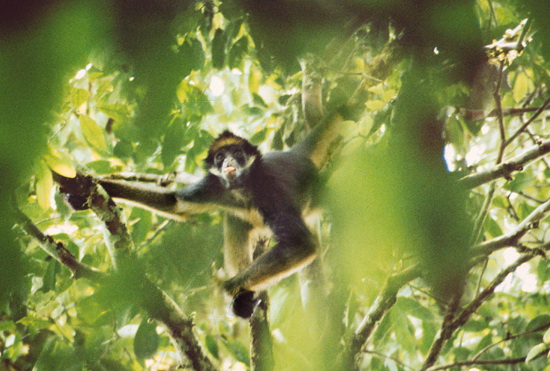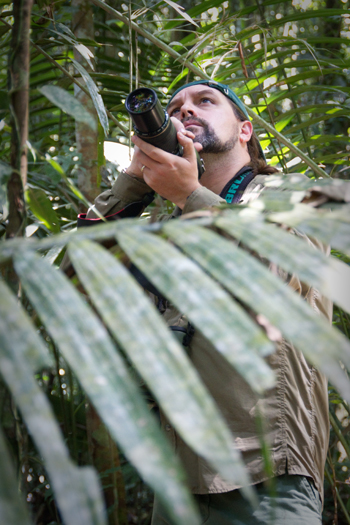W&M Primatology Network
 We
anthropologists often study social networks in action, and one of my greatest
pleasures as I approach 25 years of teaching at the College is watching the
W&M Primatology Network develop and thrive. Okay, truth be told, I’ve made
that name up. But the Anthro alums who’ve gone into primate studies are making
distinguished careers for themselves—and often they do provide advice or direct
help to W&M students just coming along in the field.
We
anthropologists often study social networks in action, and one of my greatest
pleasures as I approach 25 years of teaching at the College is watching the
W&M Primatology Network develop and thrive. Okay, truth be told, I’ve made
that name up. But the Anthro alums who’ve gone into primate studies are making
distinguished careers for themselves—and often they do provide advice or direct
help to W&M students just coming along in the field.
Four alums and one current undergrad have provided updates on what they’re doing now. Being proud of them all, I can’t resist adding updates in italics after each person’s submission.
From Peter Fashing ‘91
I attended W&M from 1988-1991, earning a B.A. in Anthropology and Biology. Courses taken with Barbara King and Rita Wright piqued my interest in the nonhuman primates at W&M, and I carried out a project on captive woolly monkey play behavior for my senior research project.
After completing my Ph.D. at Columbia University, carrying out postdoctoral research with the Wildlife Conservation Society, and working as a research scientist for the Pittsburgh Zoo, I began my current position as a faculty member in the Anthropology Department at California State University in Fullerton, CA in 2008.
Most of my current research efforts focus on a long-term study of the behavior, ecology, and conservation of the gelada, a little-known monkey found only in the Ethiopian Highlands, on a large, ecologically-intact montane grassland at Guassa, Ethiopia. For more details about my research, please visit http://anthro.fullerton.edu/pfashing/ and http://anthro.fullerton.edu/gelada/
BJK: Peter, who has returned to W&M several times to lecture in my classes and speak informally with my students, is now a tenured Professor at Fullerton.
From Scott Suarez ‘91
 I attended
William and Mary from 1987 to 1991. I
had entered college expecting to pursue a field in archaeology. But early in my college career, I took a
course in biological anthropology , then an advanced course on primate
communication. From there I was hooked
on primatology. I finished by taking
primate behavior. The bug took a
stronger hold when I did my senior research project on non-verbal communication
among a captive group of spider monkeys at the Norfolk Zoo.
I attended
William and Mary from 1987 to 1991. I
had entered college expecting to pursue a field in archaeology. But early in my college career, I took a
course in biological anthropology , then an advanced course on primate
communication. From there I was hooked
on primatology. I finished by taking
primate behavior. The bug took a
stronger hold when I did my senior research project on non-verbal communication
among a captive group of spider monkeys at the Norfolk Zoo.
After three years working on the effects of environmental enrichment among captive rhesus monkeys at a biomedical research facility, I was admitted to a doctoral program in primate behavior at SUNY Stony Brook. I conducted my doctoral dissertation research on the use of cognition in the foraging of white-bellied spider monkeys in the Amazon of Ecuador, spending nearly two years conducting field research. After I received my PhD in 2003, I was hired as a post-doctoral research assistant to study the diet and ranging behavior of Phayre’s leaf monkeys in Thailand. After two years there, my wife Pia and I came back to the United States and I began a teaching position in the anthropology department at Miami University.
Currently my research is still centered around the theme of the use of cognition in foraging decisions. I am working with undergraduates and faculty in the Computer Sciences and Software Engineering department to design simulation models against which to compare the behavior of wild monkeys. The first publication from this venture was recently accepted for publication, and we have just begun a new project to model energy-efficient traveling in a geologically complex environment. I have also recently returned to Ecuador with students to study the ranging patterns of squirrel monkeys. It is my hope to continue field research in the Ecuadorean Amazon, brining students, and eventually my two boys, Elliott and Oliver to the field with me.
BJK: Here Scott is pictured in Ecuador, photographing spider monkeys.
From Christy Hoffman ’03:
Since graduating with double majors in Anthropology and Biological Psychology (now called Neuroscience at W&M), I have had a number of exciting research experiences. My master’s and PhD research at the University of Chicago focused on free-ranging rhesus macaque behavior and physiology. The monkeys I studied live on Cayo Santiago, which is an island in the Caribbean that is part of Puerto Rico. I actually began studying this population as an undergraduate research assistant during the summer of 2002.
Oddly enough, that experience living in Puerto Rico and studying inspired my current research interests. During that summer, I became aware that people’s attitudes regarding dogs vary widely, and my fascination with anthrozoology, a burgeoning field of inquiry focused on human-animal interactions, developed. During a two-year post-doc, my research became very anthrozoological, as I focused on the effects of pets (dogs, primarily) on child psychological develop. This research was funded by the National Institutes of Health, which is very exciting because it signals that even the federal government has noted the potential benefits associated with pet ownership.
As a brand new assistant professor in the departments of Anthrozoology and Animal Behavior, Ecology, and Conservation at Canisius College in Buffalo, NY, I am continuing my collaboration with my post-doc adviser and am preparing to launch new research projects examining factors that make the human-dog relationship successful. That is, I want to know what factors enable both species in the relationship to benefit and what those benefits are. Fortunately, one of the best animal shelters in the country is right here in the Buffalo area, and I plan to partner with that shelter as my research develops.
BJK: Congratulations to Christy, who is in her first semester of tenure-track teaching and research at Canisius!
From Brittany Fallon ‘11
How I miss the W&M family! I graduated from W&M in Anthropology/Linguistics, and will receive my M.Sc. in Comparative & Evolutionary Cognition at the University of St Andrews this fall. My thesis examined gestural communication in wild chimpanzees in the Budongo Forest of Uganda, specifically the gestures that males use to communicate sexual interest to females. A bit X-rated for sharing work with Mom, but extremely interesting from a cognitive standpoint! Males can use very simple courtship displays, perhaps a single ‘come hither’ gesture; however, they can also use a combination of gestures with varying degrees of audibility or emphasis.
I’ve finished all formal requirements for the M.Sc., and will now continue to work on a similar topic for my Ph.D. with Dr. Klaus Zuberbüler at Université Neuchâtel and Dr. Richard W. Byrne at the University of St Andrews.
I’m in Uganda from September 2012-March 2013 on fieldwork. W&M alums should start a log of who’s going to which conferences; those of us who are new might appreciate a W&M alum to attach themselves to.
BJK: While at W&M, Brittany carried out a fabulous enrichment project to boost the welfare of chimpanzees at the Metro Richmond Zoo, based on her volunteer work at the fabulous Save the Chimps Sanctuary in Florida.
From Mitch Caudill ‘14
I’m a junior, anticipating graduation in the Spring of 2014. Currently, I am drafting a proposal for consideration to carry out an Honors Thesis in Anthropology next year, based on fieldwork at a chimpanzee field site in Cameroon that I will carry out this coming summer. For the past two summers, I have conducted primate behavior research at the Smithsonian National Zoo and the San Diego Zoo.
When not spending summers doing primate research, I work in Professor Dan Cristol’s Biology lab studying zebra finches. After graduation I hope to attend veterinary school, and pursue medical and behavioral research aimed at improving the welfare of primates and other animals in the wild and captivity.
BJK note: Mitch’s internship at the San Diego Zoo in summer ’12 was a funded one, and prestigious!
 Skip to main content
Skip to main content
